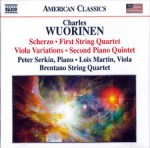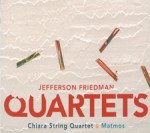Column Name
Title
Charles Wuorinen: Chamber Music. Peter Serkin, piano; Curtis Macomber, violin; Jesse Mills, violin; Lois Martin, viola; Fred Sherry, cello; Brentano String Quartet. (Naxos 8.559694)
Body
Peter Serkin kicks off this Wuorinen lovefest with a recent Scherzo (2007), for which only the most technically assured pianists need apply. Its 10 minutes include constantly changing tempos and rapid lines intersecting in a thoroughly virtuosic display. But the next piece, Wuorinen’s First String Quartet (from 1971), shows that his reputation for bold, knotty complexity was deserved early in his career. Given a reading of astonishing confidence by violinists Curtis Macomber and Jesse Mills, violist Lois Martin, and cellist Fred Sherry (all of whom are Juilliard graduates and two of whom, Macomber and Sherry, are on the faculty) this is “music that invites multiple listenings,” to quote Frank Oteri’s excellent liner notes. Its angular details have been well caught by engineer Judith Sherman at SUNY Purchase. (She recorded the remainder of the program at the American Academy of Arts and Letters.)
Martin plunges into the Viola Variations, which were written for her in 2008, with startling ferocity. In scarcely 14 minutes, Wuorinen, who was born in 1938, asks the violist to traverse the entire range of the instrument, starting with a controlled glissando on the lowest string. Contrasts abound: agitated presto flights mix with calm chorales, wiry textures alternate with throaty double-stops.
Serkin returns for a fiery reading of the composer’s Second Piano Quintet (2008), with the all-Juilliard alumni Brentano String Quartet, comprising violinists Mark Steinberg and Serena Canin, violist (and faculty member) Misha Amory, and cellist Nina Lee. Here Wuorinen begins with a dazzling, short introduction leading into a longer slow movement in which the players seem frozen in space before the third movement—which functions like a brief rondo—scampers into view for just over two minutes. In this performance, the fourth movement feels like the work’s emotional core, with the strings offering calm chords while the piano rumbles underneath. The brief finale, a prestissimo of blazing difficulty, returns to some of the earlier antics, with an unexpectedly offhand gesture to close it all out.
Jefferson Friedman: String Quartets Nos. 2 and 3. Chiara String Quartet and Matmos. (New Amsterdam Records NWAM030)
Tense flourishes open Jefferson Friedman’s Second String Quartet (1999), and despite some moments of relative calm, the first movement brims with Bartokian fury. Friedman, who was born in 1974, received his M.M. in composition from the School in 2001, wrote the work for the Chiara String Quartet, the graduate quartet in residence at Juilliard from 2003 to 2005. Here the ensemble (Rebecca Fischer and Julie Hye-Yung Yoon, violins; Jonah Sirota, viola; Gregory Beaver, cello) delivers a bravura performance. The elegiac middle movement seems to come from a place of great delicacy—and pain. Whatever inspired Friedman must have been agonizing. The piece ends with a movement marked “quarter note equals 120,” yet much of the finale is remarkably sustained, only accelerating to a rapid clip in the final pages.
The Third Quartet (2005) also opens with frantic energy, but it is quickly snuffed out in just over two minutes. The second movement—which is almost twice as long as the two outer ones combined—begins with repeated descending minor seconds, creating an eerie haze. The cello brings sustained, chorale-like chords to the fore, creating a hymnlike sound. The spell is broken in the middle when another nervous motif enters, echoing the movement’s opening but now with much more velocity. Calm then returns, evoking Barber’s Adagio—with Friedman eliciting timbres from the strings that are sometimes more akin to those of a harmonica. A torrent of high frequencies fills the final pages, the violins gradually limping downward as the viola and cello drift up, increasing in speed to the end of the section. The final movement, “Epilogue/Lullaby,” has the ensemble droning in quiet cluster chords, with each instrument emerging to offer plaintive solos, before a celestial ending.
The handsomely produced CD package features arresting paintings by Anthony Hawley, whose work provides an ideal complement to Friedman’s music. The entire project was recorded with impressive detail and veracity by Andy Bradley at Rice University’s Shepherd School of Music.
And the fun kicker: Using material from each quartet, the laptop duo Matmos (Drew Daniel and Martin Schmidt) contributes two remixes (“A Bruit Secret Mix” and “Floor Plan Mix,” which are about 5 and 10 minutes, respectively), collages of squiggles, percussive beats, and a hint of radio static. The longer one (“Floor Plan Mix”) is slower and more hallucinatory, with walls of electronic chatter and sine wave fuzz—perhaps more akin to musique concrète. But the first is almost something one could dance to. Imagine being at a dance club and grooving to Jefferson Friedman—hey, why not?






